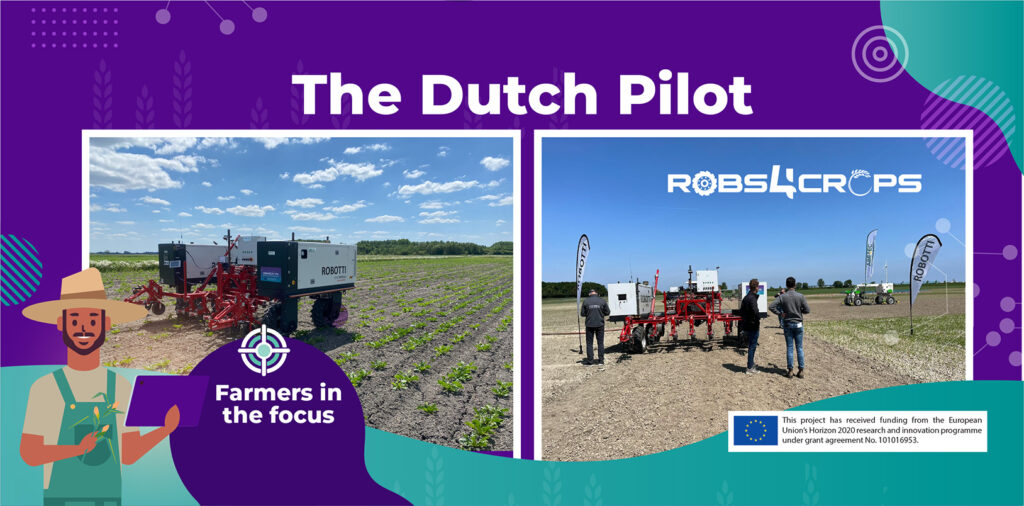The objective of the Dutch pilot is to minimize the ecological footprint of arable farming by substituting chemical weed management with autonomous mechanical weeding. Since 2023, sugar beets have been the specific crops being considered for this pilot, while pumpkins were included in the initial years of the project. These crops demonstrate slow initial growth, necessitating multiple weed control interventions throughout their growth period. To carry out this task, the Robotti robot, specifically designed for arable farming operations, is employed. The Dutch pilot team shed some light on the empowering farmers focus. The Dutch pilot team emphasizes the empowerment of farmers through this initiative, shedding light on their commitment to enable farmers in adopting more sustainable and efficient practices.
 1.What are the primary concerns and reservations surrounding the implementation of robots in agriculture, and how can these challenges be effectively addressed?
1.What are the primary concerns and reservations surrounding the implementation of robots in agriculture, and how can these challenges be effectively addressed?
The main apprehension surrounding the integration of robots in agriculture revolves around the control aspect of these machines. Farmers are concerned about ensuring that the robots perform their tasks effectively. To effectively address this challenge, within Robs4Crops we are focusing on creating a weeder implement with advanced control capabilities.
 2.What practical steps can be taken to adapt existing farming infrastructure and seamlessly integrate robotic systems, empowering farmers to optimize their operations?
2.What practical steps can be taken to adapt existing farming infrastructure and seamlessly integrate robotic systems, empowering farmers to optimize their operations?
The initial step towards seamless integration of robotic systems is to start with a single robot implementation. Farmers need time to become familiar with the functioning of these robots, as it involves a different mindset compared to traditional machinery like tractors. A period of at least one year dedicated to learning and adapting to the robotic system is necessary. Patience plays a crucial role in this process.
 3. In order to work alongside robots, how can farmers and agricultural workers adapt, acquire necessary skills, and seize opportunities for retraining and upskilling, ultimately empowering themselves in the agricultural sector?
3. In order to work alongside robots, how can farmers and agricultural workers adapt, acquire necessary skills, and seize opportunities for retraining and upskilling, ultimately empowering themselves in the agricultural sector?
Acquiring the necessary skills to work alongside robots in agriculture is primarily a “learning by doing” process. It involves a combination of training and practical experience. Initially, farmers need to undergo training on the navigation platform and familiarize themselves with the required settings. Understanding the decision-making process of robotic systems is also crucial. Subsequently, practical usage and trial-and-error play a vital role in gaining expertise.
 4. What will be the main focus of your demonstration sessions this season, considering the previous question?
4. What will be the main focus of your demonstration sessions this season, considering the previous question?
Our main objective during the upcoming demonstration sessions is to showcase the successful operation of a robotic system in the field. However, we aim to emphasize that thinking like a robot is not always a straightforward task. Each interaction with the robot is a learning experience, akin to the initial stages of using a tractor. It will take time and practice to fully grasp the capabilities and intricacies of robotic agriculture.
 5.How can farmers and other stakeholders effectively collaborate with technology developers and researchers to address the specific challenges and limitations of robotic agriculture?
5.How can farmers and other stakeholders effectively collaborate with technology developers and researchers to address the specific challenges and limitations of robotic agriculture?
Considering the demanding nature of farming tasks, farmers often have limited time available to experiment and troubleshoot with robots. To facilitate effective collaboration, it would be beneficial to organize on-field demonstrations and individualized drives with farmers and robots. This hands-on approach allows for direct engagement and attention from a small group of farmers. By bringing farmers and stakeholders together, we can collectively address the challenges and limitations of robotic agriculture in a practical and meaningful way.

